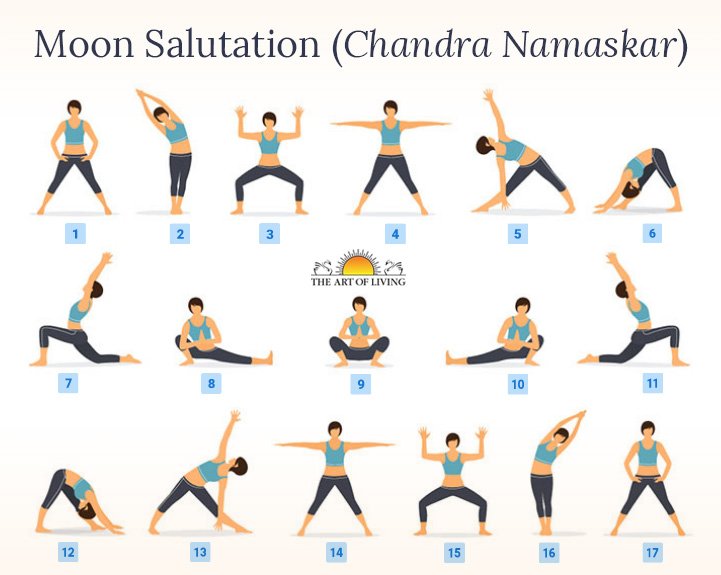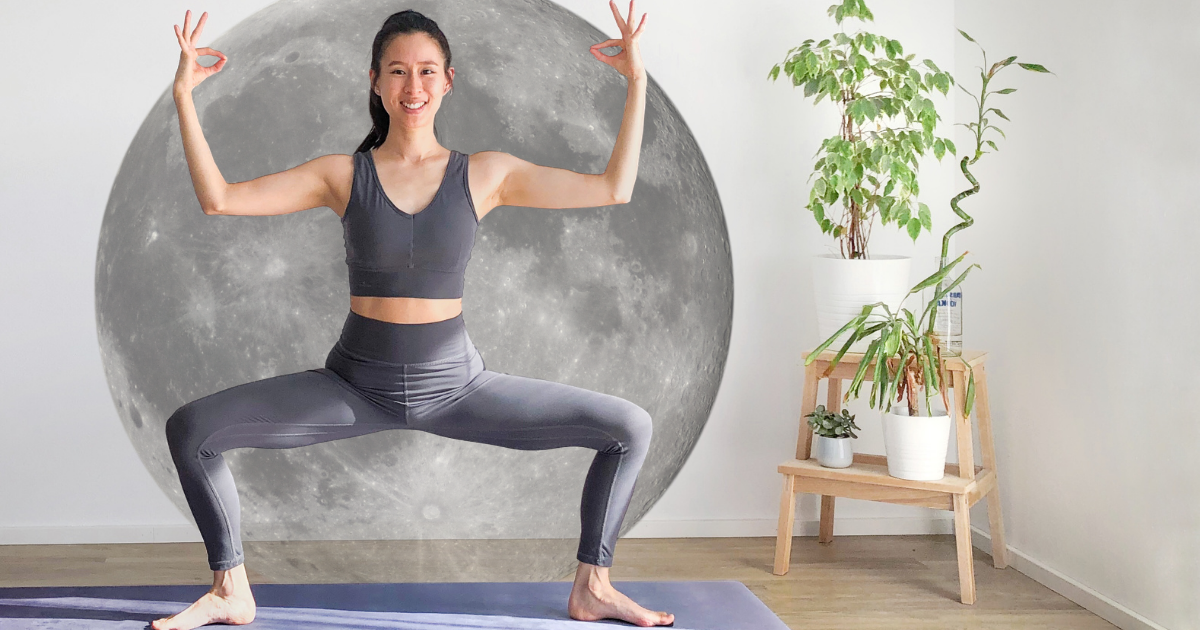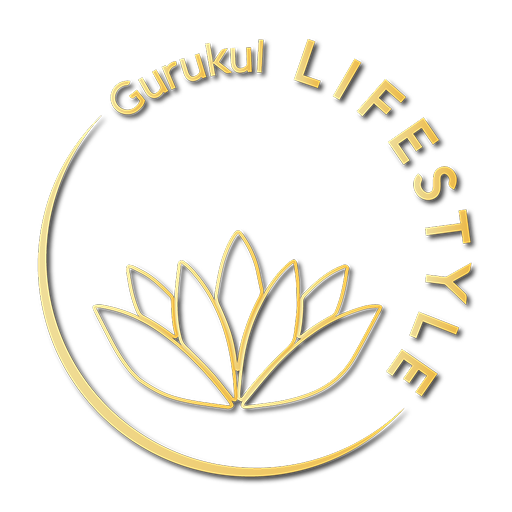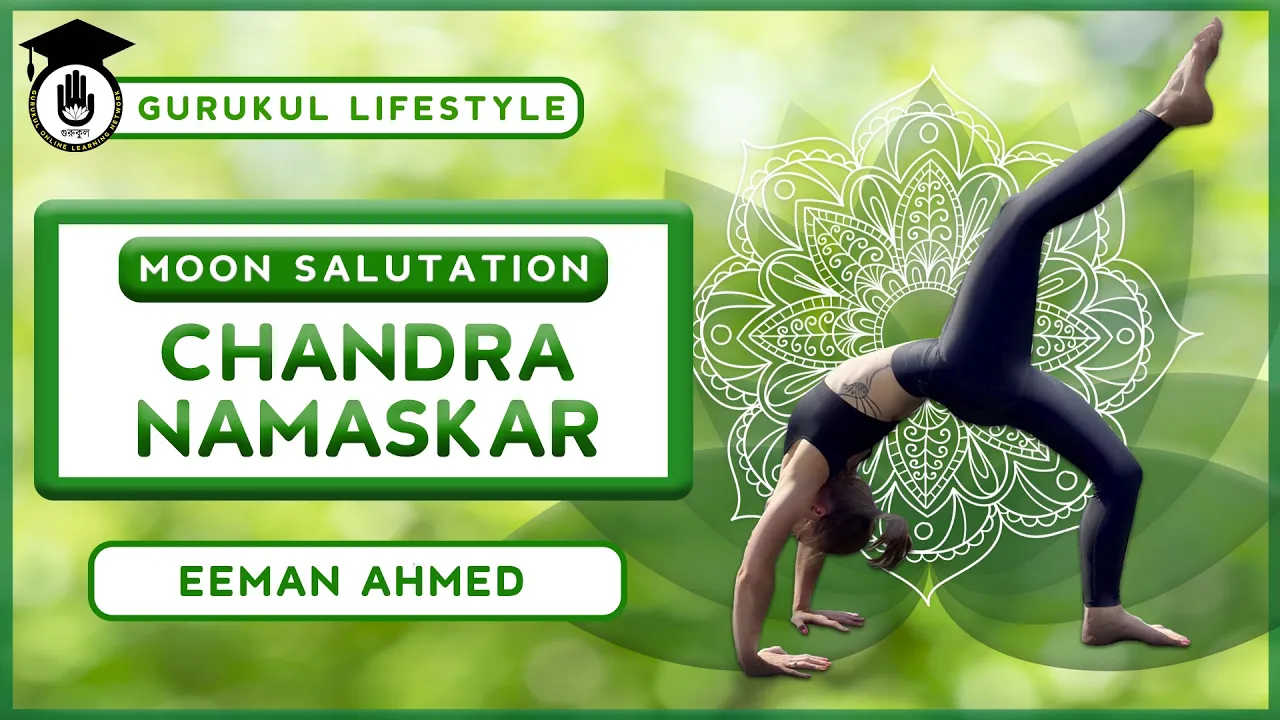Moon Salutation is the 10th class of our Yoga lesson of Gurukul Lifestyle. In this episode, Eeman will show you the process of Moon Salutation or Chandra Namaskar. The Moon Salutation, known in Sanskrit as “Chandra Namaskara” (SHAHN-drah nah-muh-SKAR-uh), is a series of poses performed in a particular sequence to create a cooling flow of movement. Like the popular Sun Salutations (Surya Namaskara), each pose in a Moon Salutation is coordinated with your breathing: Inhale to extend, and exhale to bend.
But unlike Sun Salutations, which are heating and stimulating, Moon Salutations are cooling and quieting. They are used to calm the mind and draw your awareness inward. Moon Salutations are useful when energy or temperatures are high and a tranquil, quiet presence is required.
Moon Salutation
What Is a Moon Salutation?
A moon salutation (Chandra Namaskar) refers to a sequence of yoga poses that helps the yogi calm the central nervous system and prepare the body for rest. This sequence features low-impact asanas (poses) like mountain pose, star pose, low and lateral lunges, pyramid pose, and triangle pose. In Sanskrit, the ancient Indian language that yoga was born out of, Chandra means “moon,” and Namaskar means “salutation.”
Moon salutations are a variation of sun salutations (Surya Namaskars). While moon salutations focus on calming the body, sun salutations help the practitioner energize the body and mind.

When to Practice Moon Salutations
Practice moon salutation sequences any time of day to cool down the body, but there are a few beneficial times to practice this sequence:
- At the end of a yoga practice. Moon salutations are also a great sequence to perform at the end of a yoga practice or yoga class to cool the body down after a workout, balancing the yin and yang energies in the body.
- Before bed. When aligned with a steady and slow breath, this cooling set of yoga poses can help alleviate sleep problems and wind down your mind before bed for an overall increase in wellness.
- During the new or full moon. To align with the moon’s cycles, yogis can practice this sequence of poses to honor the new moon or full moon.
How to Practice a Moon Salutation Sequence
In contrast to most Hatha yoga sequences, moon salutations are practiced facing sideways on the long end of the mat. It is vital to maintain a connection with your breath and allow your inhale to precede each transition slightly. Here is a step-by-step guide to practicing Chandra Namaskar:
- 1. Mountain pose (Tadasana). Enter mountain pose by standing on the mat with your feet hip-width distance apart and bring your hands to your heart in an Anjali mudra. Press both palms together with equal weight on both hands and roll your shoulders back and down.
- 2. Upward mountain (Urdhva Hastasana). On an inhalation, bring your arms up over your head, clasp your hands together and allow the pointer fingers to release straight up, pressing the palms together.
- 3. Standing half moon (Konasana II). Lift up and out of your torso and bend to the right side, stretching your intercostal muscles on the right side of the body. Keep the chin tucked slightly. Breathe.
- 4. Goddess pose (Utkata Konasana). Bring your arms to your side in a cactus shape with palms up and elbows at your sides. Pivot your feet, so the toes face out, and the heels face in. Bend at the knees and sit deep into your hips. Breathe.
- 5. Star pose. From Goddess, pivot the feet the opposite way, so the heels face out, and the toes face in. Bring your arms wide above your head, extended outwards, so your body makes the shape of a star, your head being the fifth point.
- 6. Triangle pose (Trikonasana). To enter triangle pose, pivot toward your right leg, so your upper body is facing the short end of the mat. With straight legs, bring your right arm to rest gently on your right shin, and lift your left arm in the air. Keep your hips in like your body is wedged between two pieces of glass.
- 7. Pyramid pose (Parsvottanasana). Still facing the right leg with the upper body, bring your hands above your head and clasp your fingers together on an inhale. Bend forward with straight legs towards the right knee on an exhale. Reach your forehead as close to your knee as you comfortably can.
- 8. Low lunge (Anjaneyasana). Bring your arms over your head on an inhale, palms facing each other, and drop your left knee on the mat. Reach up and expand through the chest, leaning forward into the right hip.
- 9. Side lunge. From low lunge, turn sideways, so you are facing the long edge of the mat again. Bend into the right leg and lengthen through the left leg. Bring your hands to your heart center and breathe. Flex the left toes towards your face. Learn more about lateral lunges in our complete guide.
- 10. Garland pose (Malasana). Bring both knees up, with your heels rooted to the floor. Sit down between your knees. Press your knees open with your elbows with hands at heart center. Sink deep into the hips but sit up tall through the spine and upper body.
- 11. Side lunge. Bend into the left leg and lengthen through the right leg. Bring your hands to your heart center and breathe. Flex the right toes towards your face.
- 12. Low lunge (Anjaneyasana). Bring your arms over your head on an inhale, palms facing each other, and drop your right knee onto the mat. Reach up and expand through the chest, leaning forward into the left hip.
- 13. Pyramid pose (Parsvottanasana). Still facing the left leg with the upper body, tuck the toes and lift the knee into a pyramid pose on the other side. Bend forward with straight legs towards the left knee on an exhale. Reach your forehead as close to your knee as you comfortably can.
- 14. Triangle pose (Trikonasana). Pivot toward your left leg, so your upper body is facing the short end of the mat. With straight legs, bring your left arm to rest gently on your left shin, and lift your right arm above you. Keep your hips in like your body is wedged between two pieces of glass.
- 15. Star pose. Pivot the feet, so the heels face out, and the toes are facing in. Bring your arms wide above your head extended outwards, so your body makes the shape of a star, your head being the fifth point.
- 16. Goddess pose (Utkata Konasana). Bring your arms to your side in a cactus shape with palms up and elbows at your sides. Pivot your feet, so the toes face out, and the heels face in. Bend at the knees and sit deep into your hips. Breathe.
- 17. Standing half-moon or crescent pose (Konasana II). Step the feet in and straighten your legs. Bring your arms up above your head and interlock your fingers, pointer fingers released. Lift up and out of your torso and bend to the left side, stretching your intercostal muscles on the entire left side of the body. Keep the chin tucked slightly. Breathe.
- 18. Upward mountain (Urdhva Hastasana). Come out of your side bend. On an inhalation, bring your arms straight up over your head, clasp your hands together, and allow the pointer fingers to release straight up, pressing the palms together.
- 19. Mountain pose (Tadasana). Stand on your mat with feet hip-width distance apart and bring your hands to your heart in an Anjali mudra. Press both palms together with equal weight on both hands and roll your shoulders back and down.

Moon Salutation Details ঃ
Read More-

